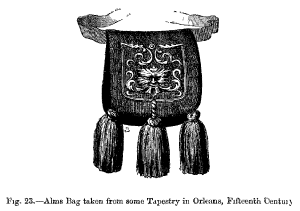Alms or almsgiving is the general practice of charitable giving to the poor; it is based upon any number of religious teachings. In the Abrahamic religions, alms are given as charity to benefit the poor. In Buddhism, alms are given by lay people to monks to nurture laic virtue, merit and blessings and to ensure monastic continuity. It was a common practice in the ancient world that extended from Greece to China to give away a portion of one's profit or spoils of war.
Related to almsgiving is the practice of giving a tithe. In English, Greek, and Hebrew, the word âtitheâ comes from a derivative of the number âten.â Cuneiform tablets contain frequent references to tithing in ancient Chaldea and Ugarit in Syria. The great temples of Babylonia were largely supported by the esra, or tithe, which was levied on prince and peasant alike. Tithing in ancient cultures is invariably associated with a sacrificial system and offerings to a god or gods.[1]
Giving generously to the poor and to support one's religion is invaluable for one's personal development, as it cultivates the habit of living for the sake of others. Almsgiving also benefits society by redistributing wealth to the most needy. It provides a way for wealthy people to practice virtue, by offering of their wealth to benefit the public good (see philanthropy).
Alms offered blindly may foster unwanted dependency. The adage, "Give a man a fish and he will eat for a day. Teach a man to fish and he will eat for a lifetime" is germane; the concept that the highest form of giving is to help a person to become self-supporting was first described by Maimonides in his "Eight Degrees of Charity."
Judaism
Tithing in the Jewish tradition shows up some five centuries before the Law was given to Moses. In the Book of Genesis, Abraham journeys through the land of Canaan and encounters Melchizedek, who was both king of the city of Salem (modern Jerusalem) and priest of the most High God. In Genesis 14:18â20, Abraham was blessed by Melchizedek and Abraham in return gave Melchizedek âa tithe of all.â
Some Jewish scholars argue, however, that Abraham was giving a tenth of the spoils of war that mostly belonged to the kings of Sodom and Gomorrah. The argument is that this giving was in compliance with ancient traditions but not the tradition of tithing which didn't come until later.
Judaism made charity a central and imperative duty for each believer. In the fifth book of Moses (Deut. 14:22), tithing was made a compulsory obligation.
Three separate tithes were prescribed in Jewish tradition:
- An annual tithe, to be paid towards the support of the Levites, priests, and other religious personnel, who were not allowed an inheritance of their own and thus were at the mercy of the state (see Num. 18:21â24).
- A separate annual feast tithe, which went towards the expenses and upkeep of the Temple, and the various feasts and sacrifices surrounding it (see Deut. 14:22â27).
- A third-year tithe for the poor of the land, and again for the Levite (see Deut. 26:12 ff).
In 1201 the medieval writer Moses Maimonides codified the Talmudic rules in the Eight Degrees of Charity. The highest sanction given was to the kind of helpfulness that anticipated charity by preventing poverty.[2]
Christianity
Whereas the principle of almsgiving in Christianity is not a legal concept as in Islam, giving to the poor is regarded as one of the highest duties for any Christian. The offertory is the traditional moment in every Roman Catholic Mass, when alms are collected. In all Christian forms of worship, a collection is made of "tithes and offerings" given for the support of the church and for the relief of the poor, as a central act of Christian worship. In addition, private acts of charity, considered virtuous only if not done for others to admire, are a Christian duty:
Take heed that you do not do your charitable deeds before men, to be seen by them. Otherwise you have no reward from your father in heaven. (Matt. 6:1)
Roman Garrison analyzes how and why the early Christian doctrine that riches prevent entrance into the kingdom of God came to be replaced by a doctrine of "redemptive almsgiving" in the Apostolic Fathers. This new doctrine, which "emerges unchallenged in early Christianity" (10), promotes almsgiving as an alternate form of atonement, "earning the individual entrance into the kingdom of God" (10) and competing with the death of Jesus as "the unique atonement for sin
Islam
Islamic scriptural rules on alms are quite reminiscent of the biblical instructions:
If you give alms openly, it is well; but if you do it secretly and give to the poor, that is better. (Qur'an 2:271a)
In Islam, zakat, or the giving of alms, is the third of the five pillars of Islam. Various rules attach to the practice, but in general terms, it is obligatory to give away 2.5 percent of one's savings and business revenue, as well as 5-10 percent of one's harvest, to the poor. The recipients include the destitute, the working poor, those who are unable to pay off their own debts, stranded travelers, and others who need assistance, with the general principle of zakaah always being that the rich should pay it to the poor.
Buddhism
In Buddhism, alms or almsgiving is the respect given by a lay Buddhist to a Buddhist monk. The monk will then pray for the giver's family or requested others. It is not charity as presumed by Western interpreters. It is closer to a symbolic connection to the spiritual and to show humbleness and respect in the presence of normal society. The visible presence of monks is a stabilizing influence. The act of alms giving assists in connecting the human to the monk and what he represents. As the Buddha has stated:
- Householders & the homeless [monastics]
- in mutual dependence
- both reach the true Dhamma.... (Itivuttaka 4.7)[3]
In Theravada Buddhism, many monks (PÄli: bhikkhus) go on a daily almsround (or pindabat) to collect food. This is often perceived as giving the laypeople the opportunity to make merit (PÄli: puñña). Money should not be accepted by a Buddhist monk, although nowadays not many monks keep to this rule (the exception being the monks of the Thai Forest Tradition and other Theravada traditions which focus on vinaya and meditation practice). In countries that follow Mahayana Buddhism, it has been impractical for monks to go on a daily almsround. In China, Korea and Japan, monasteries were situated in remote mountain areas where it could take days to reach the nearest town, thus making the daily almsround impossible. In the Himalayan countries, the large number of bikshus would have made an almsround a heavy burden on families. Competition with other religions for support also made daily almsrounds difficult and even dangerous; the first monks in the Silla dynasty of Korea were said to be beaten due to prevailing attitudes toward the Buddhist minority at the time.
In Buddhism, both "almsgiving" and, more generally, "giving" are called "dÄna" (PÄli).[4] Such giving is one of the three elements of the path of practice as formulated by the Buddha for laypeople. This path of practice for laypeople is: dÄna, sÄ«la, bhÄvanÄ.[4][5]
Generosity is also expressed towards other sentient beings as both a cause for merit and to aid the receiver of the gift. It is accepted that although the three jewels of refuge are the basis of the greatest merit, by seeing other sentient beings as having Buddha nature and making offerings towards the aspirational Buddha to be within them is of equal benefit. Generosity towards other sentient beings is greatly emphasized in Mahayana as one of the perfections (paramita) as shown in Lama Tsong Khapa's The Abbreviated Points of the Graded Path:
- Total willingness to give is the wish-granting gem for fulfilling the hopes of wandering beings.
- It is the sharpest weapon to sever the knot of stinginess.
- It leads to bodhisattva conduct that enhances self-confidence and courage,
- And is the basis for universal proclamation of your fame and repute.
- Realizing this, the wise rely, in a healthy manner, on the outstanding path
- Of (being ever-willing) to offer completely their bodies, possessions, and positive potentials.
- The ever-vigilant lama has practiced like that.
- If you too would seek liberation,
- Please cultivate yourself in the same way.[6]
In Buddhism, giving of alms, is the beginning of one's journey to Nirvana (PÄli: nibbana). In practice, one can give anything with or without thought for Nibbana. This would lead to faith (PÄli: saddha), one key power (PÄli: bala) that one should generate within oneself for the Buddha, Dhamma and Sangha.
According to the PÄli canon:
- Of all gifts [alms], the gift of Dhamma is the highest.[7]
Notes
- â Hubert Krause, and Orest Solyma, âA History of Tithing from the Bible,â The Church of God in Williamstown. Retrieved July 18, 2007.
- â Merle Curti, Philanthropy Dictionary of the History of Ideas. Retrieved July 18, 2007.
- â Thanissaro Bhikkhu (2001). Iti 107. Retrieved July 18, 2007. Almsgiving is also commended by the Buddha in a less prominent way in various other canonical texts such as the Dighajanu Sutta.
- â 4.0 4.1 "DÄna," Buddhist Dictionary. Retrieved July 18, 2007.
- â Pali Text Societyâs Pali-English Dictionary. Puñña. Digital Dictionaries of South Asia, University of Chicago. Retrieved July 18, 2007.
- â Tsongkhapa & Berzin (2001), verse 15.
- â In PÄli, this line is: Sabba danam, Dhamma danam jinati. This line can be found in the Dhammapada, chap. 24, verse 354. Thanissaro (1997) translates this entire verse as:
- A gift of Dhamma conquers all gifts;
- the taste of Dhamma, all tastes;
- a delight in Dhamma, all delights;
- the ending of craving, all suffering
- & stress.
ReferencesISBN links support NWE through referral fees
- Chrysostom, John. 1998. On Repentance and Almsgiving. The Fathers of the Church, a new translation, v. 96. Catholic University of America Press. ISBN 0813211964
- Garrison, Roman. 1993. "Redemptive Almsgiving in Early Christianity." Journal for the study of the New Testament, 77. JSOT Press. ISBN 1850753768
- Mahathera, Nyanatiloka. Buddhist Dictionary: Manual of Buddhist Terms and Doctrines, 4th ed. Kandy, Sri Lanka: Buddhist Publication Society. ISBN 9552400198. Available online. Retrieved July 18, 2007.
- Neusner, Jacob, Tamara Sonn, and Jonathan E. Brockopp. 2000. Judaism and Islam in Practice: a Sourcebook. Routledge. ISBN 0415216737
- Pali Text Society. The Pali Text Society's Pali-English dictionary. London: Chipstead. Available online from the University of Chicago. Retrieved July 18, 2007.
External links
All links retrieved July 23, 2023.
- Alms and Almsgiving Catholic Encyclopedia
- Almsgiving (Zakat) Five Pillars of Islam
- Alms Jewish Encyclopedia
- Alms Giving Ceremony in Bangkok Buddhism in Thailand
Credits
New World Encyclopedia writers and editors rewrote and completed the Wikipedia article in accordance with New World Encyclopedia standards. This article abides by terms of the Creative Commons CC-by-sa 3.0 License (CC-by-sa), which may be used and disseminated with proper attribution. Credit is due under the terms of this license that can reference both the New World Encyclopedia contributors and the selfless volunteer contributors of the Wikimedia Foundation. To cite this article click here for a list of acceptable citing formats.The history of earlier contributions by wikipedians is accessible to researchers here:
The history of this article since it was imported to New World Encyclopedia:
Note: Some restrictions may apply to use of individual images which are separately licensed.

